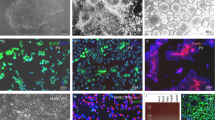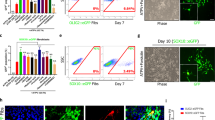Abstract
Gliomas are primary brain tumors mainly affecting adults. The cellular origin is unknown. The recent identification of tumor-initiating cells in glioma, which share many similarities with normal neural stem cells, has suggested the cell of origin to be a transformed neural stem cell. In previous studies, using the RCAS/tv-a mouse model, platelet-derived growth factor B (PDGF-B)-induced gliomas have been generated from nestin or glial fibrillary acidic protein-expressing cells, markers of neural stem cells. To investigate if committed glial progenitor cells could be the cell of origin for glioma, we generated the Ctv-a mouse where tumor induction would be restricted to myelinating oligodendrocyte progenitor cells (OPCs) expressing 2′,3′-cyclic nucleotide 3′-phosphodiesterase. We showed that PDGF-B transfer to OPCs could induce gliomas with an incidence of 33%. The majority of tumors resembled human WHO grade II oligodendroglioma based on close similarities in histopathology and expression of cellular markers. Thus, with the Ctv-a mouse we have showed that the cell of origin for glioma may be a committed glial progenitor cell.
This is a preview of subscription content, access via your institution
Access options
Subscribe to this journal
Receive 50 print issues and online access
$259.00 per year
only $5.18 per issue
Buy this article
- Purchase on Springer Link
- Instant access to full article PDF
Prices may be subject to local taxes which are calculated during checkout






Similar content being viewed by others
References
Barres BA, Hart IK, Burne JF, Voyvodic JT, Richardson WD, Raff MC . (1992). Cell death and control of cell survival in the oligodendrocyte lineage. Cell 70: 31–46.
Belachew S, Chittajallu R, Yuan X, Kirby M, Anderson S, Gallo V (2003). Postnatal NG2 proteoglycan-expressing progenitor cells are intrinsically multipotent and generate functional neurons. J Cell Biol 161: 169–186.
Bignami A, Eng LF, Dahl D, Uyeda CT . (1972). Localization of the glial fibrillary acidic protein in astrocytes by immunofluorescence. Brain Res 43: 429–435.
Binning MJ, Niazi T, Lal B, Eberhart CG, Kim KJ, Laterra J et al. (2008). Hepatocyte growth factor and sonic Hedgehog expression in cerebellar neural progenitor cells costimulate medulloblastoma initiation and growth. Cancer Res 68: 7838–7845.
Bogler O, Wren D, Land H, Noble M . (1990). Cooperation between two growth factors promotes extended self-renewal and inhibits differentiation of oligodendrocyte-type-2 astrocyte (O-2A) progenitor cells. Proc Natl Acad Sci USA 87: 6368–6372.
Bottenstein JE, Sato GH . (1979). Growth of a rat neuroblastoma cell line in serum-free supplemented medium. Proc Natl Acad Sci USA 76: 514–517.
Calver AR, Hall AC, Walsh FS, Heath JK, Betsholtz C, Richardson WD . (1998). Oligodendrocyte population dynamics and the role of PDGF in vivo. Neuron 20: 869–882.
Chandross KJ, Cohen RI, Gravel M, Braun PE, Hudson LD . (1999). Identification and characterization of early glial progenitors using a transgenic selection strategy. J Neurosci 19: 759–774.
Dai C, Celestino JC, Louis DN, Fuller GN, Holland EC . (2001). PDGF autocrine stimulation dedifferentiates cultured astrocytes and induces oligodendrogliomas and oligoastrocytomas from neural progenitors and astrocytes in vivo. Genes Dev 15: 1913–1925.
Doetsch F, Caille I, Lim DA, García-Verdugo JM, Alvarez-Buylla A . (1999). Subventricular zone astrocytes are neural stem cells in the adult mammalian brain. Cell 97: 703–716.
Dunlap SM, Celestino J, Jiang R, Holland EC, Fuller GN, Zhang W . (2007). Insulin-like growth factor binding protein 2 promotes glioma development and progression. Proc Natl Acad Sci USA 104: 11736–11741.
Ferletta M, hrbom LU, Pontén F, Westermark B . (2007). Sox10 has a broad expression pattern in gliomas and enhances platelet-derived growth factor-B-induced gliomagenesis. Mol Cancer Res 5: 891–897.
Fults D, Pedone C, Dai C, Holland EC . (2002). MYC expression promotes the proliferation of neural progenitor cells in culture and in vivo. Neoplasia 4: 32–39.
Gravel M, Di Polo A, Valera PB, Braun PE . (1998). Four-kilobase sequence of the mouse CNP gene directs spatial and temporal expression of lacZ in transgenic mice. J Neurosci Res 53: 393–404.
Holland EC, Celestino J, Dai C, Schaefer L, Sawaya RE, Fuller GN . (2000a). Combined activation of Ras and Akt in neural progenitors induces glioblastoma formation in mice. Nat Genet 25: 55–57.
Holland EC, Li Y, Dai C, Schaefer L, Sawaya RA, Fuller GN . (2000b). Astrocytes give rise to oligodendrogliomas and astrocytomas after gene transfer of polyoma virus middle T antigen in vivo. Am J Pathol 157: 1031–1037.
Holland EC, Hively WP, DePinho RA, Varmus HE . (1998). A constitutively active epidermal growth factor receptor cooperates with disruption of G1 cell-cycle arrest pathways to induce glioma-like lesions in mice. Genes Dev 12: 3675–3685.
Holland EC, Varmus HE . (1998). Basic fibroblast growth factor induces cell migration and proliferation after glia-specific gene transfer in mice. Proc Natl Acad Sci USA 95: 1218–1223.
Jackson EL, Garcia-Verdugo JM, Roy M, Quinones-Hinojosa A, VandenBerg S, Alvarez-Buylla A . (2006). PDGFR alpha-positive B cells are neural stem cells in the adult SVZ that form glioma-like growths in response to increased PDGF signaling. Neuron 51: 187–199.
Jung M, Kramer E, Blakemore W, Aguzzi A, Khazaie K, Chlichlia K et al. (1995). Lines of murine oligodendroglial precursor cells immortalized by an activated neu tyrosine kinase show distinct degrees of interaction with axons in vitro and in vivo. Eur J Neurosci 7: 1245–1265.
Lendahl U, Zimmerman LB, McKay RD . (1990). CNS stem cells express a new class of intermediate filament protein. Cell 60: 585–595.
Ling BC, Wu J, Monk KR, Shamekh R, Rizvi TA, Decourten-Myers G et al. (2005). Role for the epidermal growth factor receptor in neurofibromatosis-related peripheral nerve tumorigenesis. Cancer Cell 7: 65–75.
Liu Y, Yeh N, Leversha M, Cordon-Cardo C, Ghossein R, Singh B et al. (2007). Somatic cell type specific gene transfer reveals a tumor-promoting function for p21(Waf1/Cip1). EMBO J 26: 4683–4693.
Merkle FT, Tramontin AD, García-Verdugo JM, Alvarez-Buylla A . (2004). Radial glia give rise to adult neural stem cells in the subventricular zone. Proc Natl Acad Sci USA 101: 17528–17532.
Nishiyama A, Lin XH, Giese N, Heldin CH, Stallcup WB . (1996). Co-localization of NG2 proteoglycan and PDGF alpha-receptor on O2A progenitor cells in the developing rat brain. J Neurosci Res 43: 299–314.
Noble M, Murray K, Stroobant P, Waterfield MD, Riddle P . (1988). Platelet-derived growth factor promotes division and motility and inhibits premature differentiation of the oligodendrocyte/type-2 astrocyte progenitor cell. Nature 333: 560–562.
O’Neill RC, Minuk J, Cox ME, Braun PE, Gravel M . (1997). CNP2 mRNA directs synthesis of both CNP1 and CNP2 polypeptides. J Neurosci Res 50: 248–257.
Ohgaki H, Dessen P, Jourde B, Horstmann S, Nishikawa T, Di Patre P-L et al. (2004). Genetic pathways to glioblastoma: a population-based study. Cancer Res 64: 6892–6899.
Polito A, Reynolds R . (2005). NG2-expressing cells as oligodendrocyte progenitors in the normal and demyelinated adult central nervous system. J Anat 207: 707–716.
Pringle NP, Richardson WD . (1993). A singularity of PDGF alpha-receptor expression in the dorsoventral axis of the neural tube may define the origin of the oligodendrocyte lineage. Development 117: 525–533.
Raff MC, Lillien LE, Richardson WD, Burne JF, Noble MD . (1988). Platelet-derived growth factor from astrocytes drives the clock that times oligodendrocyte development in culture. Nature 333: 562–565.
Rao G, Pedone CA, Coffin CM, Holland EC, Fults DW . (2003). c-Myc enhances sonic hedgehog-induced medulloblastoma formation from nestin-expressing neural progenitors in mice. Neoplasia 5: 198–204.
Rao G, Pedone CA, Del Valle L, Reiss K, Holland EC, Fults DW . (2004). Sonic hedgehog and insulin-like growth factor signaling synergize to induce medulloblastoma formation from nestin-expressing neural progenitors in mice. Oncogene 23: 6156–6162.
Reynolds BA, Weiss S . (1992). Generation of neurons and astrocytes from isolated cells of the adult mammalian central nervous system. Science 255: 1707–1710.
Scherer SS, Braun PE, Grinspan J, Collarini E, Wang DY, Kamholz J . (1994). Differential regulation of the 2′,3′-cyclic nucleotide 3′-phosphodiesterase gene during oligodendrocyte development. Neuron 12: 1363–1375.
Shih AH, Dai C, Rosenblum MK, Koutcher JA, Holland EC . (2004). Dose-dependent effects of platelet-derived growth factor-B on glial tumorigenesis. Cancer Res 64: 4783–4789.
Singh SK, Hawkins C, Clarke ID, Squire JA, Bayani J, Hide T et al. (2004). Identification of human brain tumour initiating cells. Nature 432: 396–401.
Stallcup WB, Beasley L . (1987). Bipotential glial precursor cells of the optic nerve express the NG2 proteoglycan. J Neurosci 7: 2737–2744.
Stupp R, Mason WP, van den Bent MJ, Weller M, Fisher B, Taphoorn MJ et al. (2005). Radiotherapy plus concomitant and adjuvant temozolomide for glioblastoma. N Engl J Med 352: 987–996.
Tchougounova E, Kastemar M, Bråsäter D, Holland EC, Westermark B, Uhrbom L . (2007). Loss of Arf causes tumor progression of PDGFB-induced oligodendroglioma. Oncogene.
Uhrbom L, Dai C, Elestino JC, Rosenblum MK, Fuller GN, Holland EC . (2002). Ink4a-Arf loss cooperates with KRas activation in astrocytes and neural progenitors to generate glioblastomas of various morphologies depending on activated Akt. Cancer Res 62: 5551–5558.
Uhrbom L, Holland EC . (2001). Modeling gliomagenesis with somatic cell gene transfer using retroviral vectors. J Neurooncol 53: 297–305.
Uhrbom L, Kastemar M, Johansson FK, Westermark B, Holland EC . (2005). Cell type-specific tumor suppression by Ink4a and Arf in Kras-induced mouse gliomagenesis. Cancer Res 65: 2065–2069.
Vogel US, Thompson RJ . (1988). Molecular structure, localization, and possible functions of the myelin-associated enzyme 2′,3′-cyclic nucleotide 3′-phosphodiesterase. J Neurochem 50: 1667–1677.
Yuan X, Chittajallu R, Belachew S, Anderson S, McBain CJ, Gallo V . (2002). Expression of the green fluorescent protein in the oligodendrocyte lineage: a transgenic mouse for developmental and physiological studies. J Neurosci Res 70: 529–545.
Acknowledgements
We thank Michel Gravel for the mouse Cnp promoter DNA and Karin Forsberg-Nilsson for the pTG8 plasmid. This work was supported by grants from The Swedish Cancer Society, The Swedish Research Council, Association for International Cancer Research, Lars Hiertas Minne, Jeansson's Foundation, Magn. Bergvall's Foundation, Åke Wiberg's Foundation, the Department of Genetics and Pathology and the Medical Faculty of Uppsala University.
Author information
Authors and Affiliations
Corresponding author
Additional information
Supplementary Information accompanies the paper on the Oncogene website (http://www.nature.com/onc)
Supplementary information
Rights and permissions
About this article
Cite this article
Lindberg, N., Kastemar, M., Olofsson, T. et al. Oligodendrocyte progenitor cells can act as cell of origin for experimental glioma. Oncogene 28, 2266–2275 (2009). https://doi.org/10.1038/onc.2009.76
Received:
Revised:
Accepted:
Published:
Issue Date:
DOI: https://doi.org/10.1038/onc.2009.76
Keywords
This article is cited by
-
Targeting the key players of phenotypic plasticity in cancer cells by phytochemicals
Cancer and Metastasis Reviews (2024)
-
Jagged1 intracellular domain/SMAD3 complex transcriptionally regulates TWIST1 to drive glioma invasion
Cell Death & Disease (2023)
-
G-protein-coupled receptor GPR17 inhibits glioma development by increasing polycomb repressive complex 1-mediated ROS production
Cell Death & Disease (2021)
-
Dual-specificity phosphatase (DUSP6) in human glioblastoma: epithelial-to-mesenchymal transition (EMT) involvement
BMC Research Notes (2020)
-
Lgl1 controls NG2 endocytic pathway to regulate oligodendrocyte differentiation and asymmetric cell division and gliomagenesis
Nature Communications (2018)



